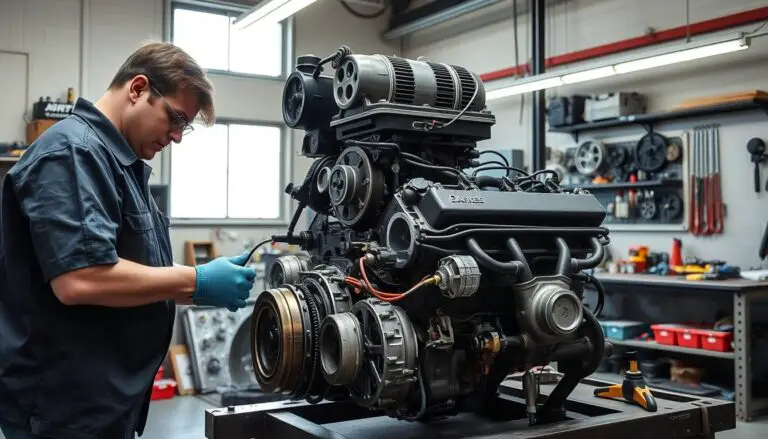Converting a 220-volt circuit to power a 110-volt outlet is a project many homeowners consider when repurposing existing electrical circuits. Whether you’re replacing an electric dryer with a gas model or need standard outlets where a 220V appliance once stood, this guide will walk you through the process safely and effectively.
While this conversion is possible for those with basic electrical knowledge, it involves working with your home’s electrical system, which carries inherent risks. We’ll cover all necessary safety precautions, required materials, and provide clear step-by-step instructions to help you wire a 110 outlet from 220V correctly.
Critical Safety Precautions Before You Begin
WARNING: Working with electricity can be dangerous and potentially fatal if proper precautions aren’t taken. If you’re uncertain about any step in this process, please consult a licensed electrician.
Essential Safety Measures
- Always turn off power at the main service panel before beginning work
- Use a voltage tester to verify power is off before touching any wires
- Wear insulated gloves and safety glasses
- Use insulated tools designed for electrical work
- Never work on wet surfaces or with wet hands
- Ensure the work area is well-lit and free from obstacles
- Follow local electrical codes and regulations
- Have a fire extinguisher rated for electrical fires nearby
Tools and Materials You’ll Need
Required Tools
- Voltage tester (non-contact and multimeter)
- Insulated screwdrivers (flathead and Phillips)
- Wire strippers
- Needle-nose pliers
- Electrical tape
- Wire nuts (appropriate size)
- Flashlight
- Utility knife
Required Materials
- 110V outlet (NEMA 5-15R or 5-20R)
- Appropriate circuit breaker (15A or 20A single-pole)
- Outlet cover plate
- Panel filler insert (if needed)
- Wire connectors
- Electrical box (if replacing)
- Optional: 2-wire cable for extending to new location

Pro Tip: Before purchasing materials, check your existing 220V circuit’s wire gauge. This will determine the maximum amperage your new 110V circuit can safely handle.
Verifying Your 220V Circuit’s Compatibility
Not all 220V circuits can be safely converted to 110V. Before proceeding, you need to verify your existing circuit’s configuration and compatibility.
Step 1: Identify Your Current Wiring Configuration
What to Look For:
- Wire gauge (typically #10 or #12 for residential 220V)
- Number of conductors (you need at least 3 wires)
- Wire colors (typically red, black, white, and bare/green)
- Current breaker size (typically 30A or 50A for 220V)
Ideal Configuration:
The best scenario for conversion is a 220V circuit with:
- Two hot wires (red and black)
- One neutral wire (white)
- One ground wire (bare or green)
This 4-wire setup allows for the easiest and safest conversion.
Important: If your 220V circuit only has two hot wires and a ground (no neutral), you cannot safely convert it to 110V without running a new neutral wire. Never use the ground wire as a neutral—this is extremely dangerous and violates electrical code.
Step 2: Test Voltage with a Multimeter

- Turn off the circuit breaker for the 220V outlet
- Remove the outlet cover plate
- Turn the breaker back on
- Use a non-contact voltage tester to verify presence of power
- Set your multimeter to AC voltage (at least 250V range)
- Carefully measure voltage between:
- Hot to hot (should read approximately 220-240V)
- Each hot to neutral (should read approximately 110-120V)
- Each hot to ground (should read approximately 110-120V)
- Turn off the breaker again before proceeding
How to Wire a 110 Outlet from 220V: Step-by-Step Process
Once you’ve verified your circuit’s compatibility, follow these steps to safely convert your 220V circuit to 110V.
Safety First: Double-check that the power is OFF at the circuit breaker before beginning any work. Use a voltage tester to verify no power is present.
Step 1: Shut Off Power and Remove the Existing Outlet
- Turn off the appropriate circuit breaker in the main service panel
- Use a voltage tester to confirm power is off
- Remove the cover plate from the existing 220V outlet
- Unscrew and remove the outlet from the electrical box
- Carefully pull the outlet out to expose the wires
- Take a photo of the existing wiring for reference
- Disconnect the wires from the outlet

Step 2: Modify the Circuit Breaker in the Main Panel
Warning: Working in the main service panel involves exposure to live electrical parts. If you’re not comfortable with this step, hire a licensed electrician.
- Turn off the main breaker to cut power to the entire panel
- Use a flashlight to locate the double-pole breaker for your 220V circuit
- Remove the panel cover carefully
- Identify the wires connected to your circuit’s breaker
- Remove the double-pole breaker (typically 30A or 50A)
- Install a single-pole breaker (15A or 20A, depending on wire gauge):
- Use 15A for #14 wire
- Use 20A for #12 wire
- If wire is #10, you can use 20A (though the wire is rated for 30A)
- Connect one of the hot wires (preferably black) to the new breaker
- Cap off the unused hot wire (typically red) with a wire nut
- Ensure the white neutral wire is connected to the neutral bar
- Verify the ground wire is connected to the ground bar
- Install a panel filler insert to cover the empty breaker space
- Replace the panel cover
- Leave the main breaker off until the outlet installation is complete

Step 3: Install the New 110V Outlet
Now that your circuit breaker has been modified, you can install the new 110V outlet at the original location.
- At the outlet box, identify the wires:
- Black wire (hot)
- White wire (neutral)
- Green or bare wire (ground)
- Red wire (capped off and not used)
- Prepare the new 110V outlet:
- Ensure the circuit breaker is still off
- Connect the black (hot) wire to the brass terminal
- Connect the white (neutral) wire to the silver terminal
- Connect the green or bare (ground) wire to the green ground terminal
- Cap the unused red wire with a wire nut and electrical tape
- Carefully fold the wires back into the box
- Secure the outlet to the box with mounting screws
- Attach the cover plate
Wiring Configuration for 110V Outlet
Follow this standard wiring pattern:
Hot (Black) → Brass Terminal Neutral (White) → Silver Terminal Ground (Green/Bare) → Green Terminal Red Wire → Cap with wire nut (not used)

Testing Your Newly Installed 110V Outlet
After installation, proper testing is crucial to ensure safety and functionality.
Step 1: Visual Inspection
- Ensure all connections are tight and secure
- Verify no bare wire is exposed outside wire nuts or terminals
- Check that the outlet is firmly mounted to the box
- Confirm the cover plate is properly installed
Step 2: Power Up and Test
- Turn on the main breaker if it was turned off
- Turn on the new single-pole breaker for your circuit
- Use a non-contact voltage tester to verify power is present at the outlet
- Use a receptacle tester to check for proper wiring:
- Correct polarity
- Proper grounding
- No open connections
- Use a multimeter to measure voltage:
- Hot to neutral should read 110-120V
- Hot to ground should read 110-120V
- Neutral to ground should read close to 0V

Step 3: Load Testing
- Plug in a simple device like a lamp
- Verify it works properly
- Try a higher-load device (if the circuit will be used for such purposes)
- Monitor for any unusual heating, buzzing, or other issues
Remember: Your converted circuit is now protected by a 15A or 20A breaker. Be mindful of the total load you place on this circuit to avoid tripping the breaker.
Alternative Options for Converting 220V to 110V
If your existing 220V circuit doesn’t have a neutral wire or if you want to maintain both 220V and 110V capabilities, consider these alternatives.
Option 1: Using a Step-Down Transformer

A step-down transformer can convert 220V to 110V without modifying your electrical panel.
Advantages
- No need to modify the electrical panel
- Maintains the original 220V circuit
- Relatively simple to install
- Portable option available
Disadvantages
- More expensive than rewiring
- Takes up physical space
- Less efficient (some power loss)
- Limited amperage capacity
Option 2: Installing a Subpanel
If you have a 4-wire 220V circuit (with neutral), you can install a small subpanel to provide both 220V and 110V circuits.
Advantages
- Provides both 220V and 110V options
- Can support multiple outlets
- Properly protected by appropriate breakers
- Most versatile long-term solution
Disadvantages
- More complex installation
- Higher cost
- Requires more space
- May need professional installation

Option 3: Running a New Circuit
Sometimes the simplest solution is to leave the 220V circuit intact and run a new 110V circuit from your main panel.
Advantages
- Preserves the existing 220V circuit
- Properly sized for 110V applications
- Can be placed exactly where needed
- No compromise on either circuit
Disadvantages
- Most labor-intensive option
- May require opening walls
- Higher material costs
- May need permits depending on locality
Common Mistakes to Avoid When Converting 220V to 110V
Safety Warning: Electrical mistakes can lead to fire, electrocution, or damage to appliances. Take your time and double-check your work at each step.

Wiring Mistakes
- Using ground as neutral: Never use the ground wire as a neutral conductor. This is extremely dangerous and violates electrical code.
- Incorrect breaker size: Using an oversized breaker for the wire gauge can create a fire hazard.
- Loose connections: Loose terminal screws can cause arcing, heating, and potential fires.
- Mixing up wires: Connecting hot to neutral terminals or vice versa can damage equipment and create shock hazards.
Planning Mistakes
- Inadequate load calculation: Not accounting for the amperage needs of devices that will use the circuit.
- Ignoring local codes: Failing to check local electrical code requirements for your specific conversion.
- Skipping permits: Some jurisdictions require permits for electrical modifications.
- Inadequate testing: Not thoroughly testing the circuit after conversion can leave dangerous issues undetected.
“The most dangerous mistake is assuming you know enough to skip safety steps. When in doubt, consult a professional electrician.”
Frequently Asked Questions About Wiring a 110V Outlet from 220V
Can I convert a 220V dryer outlet to 110V?
Yes, you can convert a 220V dryer outlet to 110V if you’re switching to a gas dryer that only needs 110V. However, you must ensure the circuit has a neutral wire. Most modern dryer outlets (NEMA 14-30) have four wires: two hots, a neutral, and a ground, making conversion possible. Older three-wire dryer outlets may not have a separate neutral and ground, which complicates safe conversion.
What if my 220V circuit doesn’t have a neutral wire?
If your 220V circuit only has two hot wires and a ground (no neutral), you cannot safely convert it to 110V without running a new neutral wire from the panel. Never use the ground wire as a neutral—this creates a serious safety hazard. In this case, consider using a step-down transformer or running a new 110V circuit instead.
Can I get both 110V and 220V from the same circuit?
Yes, with a 4-wire circuit (two hots, neutral, and ground), you can install a small subpanel that provides both 220V and 110V outlets. This requires proper breaker protection for each circuit type but allows maximum flexibility. This is often the best solution if you need both voltage types in the same area.
What size breaker should I use for the converted 110V circuit?
The breaker size depends on the wire gauge of your existing circuit:
- #14 AWG wire requires a 15A breaker
- #12 AWG wire requires a 20A breaker
- #10 AWG wire (common for 220V circuits) can use a 20A breaker (though the wire is rated for 30A)
Never use a breaker rated higher than the wire’s capacity, as this creates a fire hazard.
Do I need a permit to convert a 220V circuit to 110V?
Permit requirements vary by location. Many jurisdictions require permits for any modification to your electrical system, including converting voltage. Check with your local building department before starting work. Even if not legally required, getting a permit ensures your work will be inspected for safety and code compliance.
How much load can I put on my converted 110V circuit?
Your converted circuit will be limited by the breaker size you install:
- 15A circuit: maximum 1,800 watts (15A × 120V)
- 20A circuit: maximum 2,400 watts (20A × 120V)
For continuous loads (running for 3+ hours), limit the load to 80% of these values (1,440 watts for 15A, 1,920 watts for 20A).

Conclusion: Successfully Wiring a 110V Outlet from 220V
Converting a 220V circuit to 110V can be a practical solution when your electrical needs change. By following the proper steps and prioritizing safety, you can successfully complete this conversion and repurpose your existing wiring for standard household outlets.
Key Takeaways
- Always verify circuit compatibility before beginning
- Never use the ground wire as a neutral
- Ensure proper breaker sizing for wire gauge
- Test thoroughly after installation
- Consider alternative options if your circuit lacks a neutral wire
When to Call a Professional
- If you’re unsure about any step in the process
- When working in the main service panel feels uncomfortable
- If your circuit lacks a neutral wire and needs one added
- For complex installations like subpanels
- When local codes require licensed electrician work

Final Safety Reminder: Electrical work carries inherent risks. If at any point you feel uncomfortable or uncertain about the process, don’t hesitate to contact a licensed electrician. Your safety and the safety of your home are paramount.


